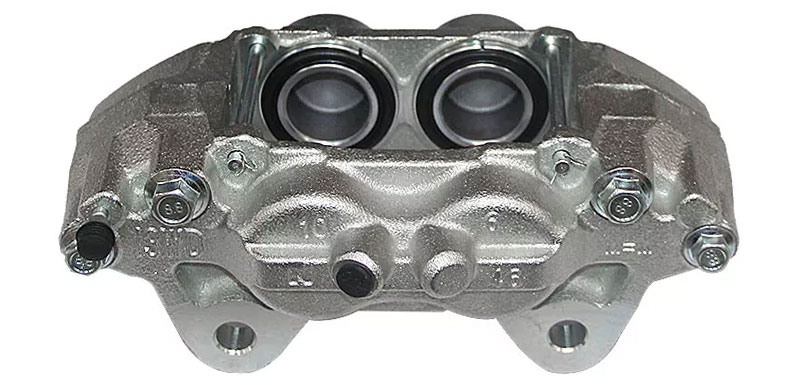There are few safety-sensitive automotive systems as vital as a car’s brakes. A vehicle’s brakes allow us to reduce our speed whenever necessary and stop quickly to avoid collisions.
This is why it is essential that our brakes function flawlessly, under a wide array of circumstances. Unfortunately, like any other mechanical system, a vehicle’s brakes are prone to the occasional issue during a vehicle’s lifetime.
When such issues arise, they must be addressed immediately, to avoid any unnecessary risk that might stem from untimely component failure. This, of course, should be quite obvious to most, thereby motivating one to seek out a favorable resolution.
One of the most common of all brake system related issues is that which pertains to a sticking, frozen, or seized brake caliper. In fact, issues of this type are far more prevalent than one might assume, affecting an untold number of vehicles during any given year.
However, the impact of such issues can be reduced through quick diagnosis, resulting from the identification of one or more underlying symptoms. Read on to learn more about the various symptoms associated with a sticking brake caliper, as well as how to address such issues, should they arise in the future.
What Does It Mean When a Brake Caliper Is “Sticking”?
A “sticking caliper” is a brake caliper that is stuck in the applied position, failing to release, even in absence of brake pedal application. This causes continual friction between a vehicle’s brake pads and rotors, which in turn, causes a certain degree of constant brake drag.
In most cases, this constant brake drag will cause a vehicle’s brake pads and rotor at the affected wheel end location to heat beyond typical operational temperatures. This tends to magnify the issue at hand, as metal typically swells when it’s hot. This only increases friction and brake drag as a whole.
A stuck brake caliper can occur in both the front and rear of a vehicle, assuming that the vehicle in question features four-wheel disk brakes. No matter which brake assembly is affected, there is little denial of the frustration felt by a motorist when their vehicle’s brakes won’t release.
See Also – How Does Regenerative Braking Work?
Symptoms of a Stuck Brake Caliper
A sticking brake caliper often presents a number of symptoms, some of which are more noticeable than others. Learning to recognize these symptoms can be of benefit to those hoping to quickly diagnose their vehicle’s issue.
The following are several of the most common symptoms associated with a stuck brake caliper.
1. Abnormal Noise
In many cases, a sticking brake caliper can be easily identified by the abnormal sounds that it produces. This most notably includes grinding and scraping noises that result from rapid or abnormal brake pad wear.
2. Smoke
As a brake drags, excess heat is produced. In severe cases, this heat can rise to considerable levels. In some instances, smoke can actually be seen billowing from the wheel end to which the affected caliper is mounted.
3. Burning Odor
When a brake caliper sticks, it tends to wear brake pads at a considerable rate. This excess friction and rapid wear often produce a foul, burnt odor, which is easily detected, even from several yards away.
4. Pulling to One Side
Under certain circumstances, a vehicle will pull to one side or the other while driving, as the result of a sticking brake caliper. This is due to the excess rolling resistance incurred by the affected brake/hub.
As a result, a vehicle will pull to the side on which the defective brake is located.
5. Reduced Fuel Economy
It is also possible to experience a drop in fuel economy when contending with sticking or seized brake caliper. This is due to the excessive drag placed upon a vehicle, as it attempts to overpower a stuck brake assembly.
Causes of a Stuck Brake Caliper
A brake caliper can stick for one of a handful of different reasons, some of which tend to be slightly more common than others. Understanding these potential causes can prove quite valuable when attempting to diagnose the issue at hand.
The following are several of the most common causes of a stuck brake caliper.
1. Frozen Slide Pins
Brake calipers utilize slide pins to facilitate their inboard-to-outboard movement. As a brake application is made, a caliper’s brake piston forces its inboard pad against the face of the assembly’s brake rotor.
In turn, this causes the body of the caliper itself to slide upon a pair of slide pins, thereby pulling its outboard pad toward the outer face of the rotor. Unfortunately, these pins often seize due to corrosion, preventing this movement.
2. Frozen Caliper Piston
In much the same way as mentioned above, a caliper’s inboard piston can also become frozen within its bore, as a result of corrosion.
When this occurs, not only is a brake assembly’s inboard pad held against the face of its corresponding brake rotor but the unit’s outside pad is also forced into engagement with the brake rotor, due to slide pin actuation.
3. Collapsed Brake Hose
Another common cause of a brake caliper sticking is a collapsed brake hose. When a brake hose collapses, it often traps brake fluid against the internal face of a caliper’s piston, thereby preventing the full release of a brake application.
This is almost always the case if a brand new brake caliper sticks, following replacement for a similar issue. In this case, the only way to eliminate the issue at hand is to replace the compromised hose.
How Can You Tell Which Caliper Is Sticking?
The particular location of a sticking brake caliper on a vehicle can often be determined through simple observation.
In most cases, a severely frozen brake caliper can eat through a pair of brake pads in a matter of weeks or days, thereby presenting an obvious scraping or grinding noise, as a brake pad’s backing plate is drug across the face of its corresponding rotor.
In certain instances, it might also be possible to observe a light amount of smoke billowing from a brake assembly with a frozen caliper. Similarly, a hot or burnt smell tends to accompany issues of this type, as a vehicle’s brake pads quickly deteriorate under the stress of constant friction.
Is It Safe to Drive With a Stuck Caliper?
It is never advisable to knowingly drive with a brake system that is not operating at peak efficiency. Attempting to drive in this manner for any length of distance than absolutely necessary presents a significant liability in terms of safety, to yourself, your passengers, and anyone else that you are sharing the road with.
Additionally, attempting to drive with a stuck caliper can present other issues as well. Driving in this manner can quickly damage a vehicle’s brake rotor, thereby necessitating additional repair. Any hope of unsticking and salvaging a seized caliper is also quickly lost if driving does not cease.
This is due primarily to the heat that is generated from a sticking brake caliper, and the damage that results.
In any event, a sticking brake caliper should be repaired or replaced as soon as possible. Doing so prevents a host of additional issues, while also mitigating unnecessary risk.
If you do not feel 100% confident in your ability to repair the issue on your own, an appointment should be made with a trusted automotive service center at your earliest convenience.
Can the Caliper Get Un-stuck on Its Own?
It is highly unlikely that a brake caliper will “unstick” itself, in the event that it seizes. While a caliper might partially release when frozen due to corrosion, the caliper in question is virtually guaranteed to become stuck once again after several successive brake applications.
For this reason, one should never consider a situation of this type to be remedied, if a caliper seems to free itself up.
The only proper repair for a sticking brake caliper involves diagnosing the source of the issue at hand, and rebuilding or replacing the defective component in question. While most brake calipers can be rebuilt, the practice of rebuilding calipers is now far less prevalent than it once was.
Most repair shops simply replace a caliper as it fails or becomes frozen.
Cost to Fix a Seized Brake Caliper
The cost associated with fixing a seized brake caliper can vary significantly from one particular case to the next. The make and model of the vehicle to be repaired, as well as the labor rate of the shop making these repairs, all play into the total cost passed on to motorists.
For this reason, it is always advisable to have repairs of this nature quoted prior to authorization.
On average, you can expect to pay somewhere in the range of $100-$600 to fix a seized brake caliper, with the midpoint of this range likely being the most precise.
At the lower end of this price range, are repairs that simply involve unsticking a frozen caliper. Meanwhile, the upper end of this price spectrum is largely representative of caliper replacement on performance or luxury cars.
- The History of the BMW M Coupe (the “Clown Shoe”) - Mar 26, 2024
- The History of the Ford Flex - Feb 28, 2024
- Can You Trade In a Car With Body Damage or Mechanical Issues? - Feb 21, 2024






After having a new master cylinder installed, and going back several time I’ll step on brakes and pedal goes to the floor. Let it sit and it works again but it happens randomly. Drove it in traffic yesterday everything worked fine. This morning got in my older model yukon 2002 brakes are gone